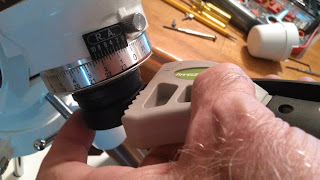THE CITIZEN C.A.T.E. EXPERIMENT:
I am a primary participant in the
Citizen C.A.T.E. (Continental-America Telescopic Eclipse) Experiment.
This n attempt to image the inner corona of the Sun during the August 21, 2017 solar eclipse. Typically scientists have only 2 to 3 minutes to image (video in particular) this portion of the Sun during an eclipse. The C.A.T.E. project aims to establish over 60 sites spread across the U.S.A. (from Oregon to South Carolina) Here is a map showing the path over Oregon:
At set distances apart, with identical equipment, to HDR (high dynamic range) video the eclipse at totality, like this image:
The video files will be sent to Matt Penn at the National Solar Observatory (NSO) after the event where they will be stitched together to (hopefully) produce up to 90 minutes of video totality for scientists to study.
MY INVOLVEMENT:
I first heard about this project in the
January 2016 edition of Sky and Telescope magazine.
Being an amateur astronomer and wanting to do something "significant" scientifically, this intrigued me and I "signed up" immediately. I had the opportunity to be a 'state coordinator' but my schedule is busier than I could handle so I deferred to a fellow Oregonian who is retired, Mike Conley of Salem, Oregon, who had done an excellent job in helping the project.
MY SITE #5 - MITCHELL, OREGON:
My site for this project is outside the little village of Mitchell, Oregon which is on the eastern side of the state. I had hoped to setup on the grounds of the
Painted Hills (part of the John Day Fossil Beds National Monuments.
But was informed by the ranger there that they are expecting untold 10's of thousands of people on that weekend because of the eclipse! A little two lane road and no parking... YIKES!
So I went to
Mitchell, Oregon last August, 2016 to see if I could setup there.
As you can see, it is just a wide spot in the road, so to speak. But the only over-night places to stay were already booked... over a year in advance! Mitchell is expecting 10's of thousands as well which is going to be problematic again for I doubt it has even 50 places to park a car! Food, water, toilets for thousands... HA! Good luck on that, you who are thinking "This is the place to be!"
And the high school football field had been commandeered by emergency services (sheriff, paramedics, fire fighting government agencies, etc) as a helipad !
So I have found (hopefully) private property (location of which I will NOT disclose for obvious reasons) on which to accomplish this task.
THE EQUIPMENT:
The equipment for this project consists of, in short, a Daystar APO 80mm telescope on a Celestron CG4 mount with a Point Grey 5 megapixel b&w camera and a solar filter (more precise listing below).
No, that is not me in the photo but others being trained for this experiment.
Some of these pieces of equipment have been donated by various manufacturers and the rest has been financially supported by organizations like the National Science Foundation, NASA, Mathworks, Celestron (just to name a few) and as well as individuals who are purchasing their own equipment.
TRAINING:
Since the aim is to get video data worthy of science the C.A.T.E. Experiment (Continental-America Telescopic Eclipse) there is a need for quality training which is where the project is at the present time. Having received the equipment a couple of week ago, we are to do what we can to practice on the Sun and on the crescent Moon, working on field alignment, focus and data capturing.
My most recent PRACTICE:
As I have had little clear skies since receiving the equipment I have had little chance to practice until yesterday. Under partly cloudy skies (which even then were uncooperative) I was able to finally get the Sun in the clear to produce the following images. My goal was to image the tiny sunspot near the edge of the solar disk. After post-processing (sharpening, contrast and brightness, and sepia for effect) this is what I came up with (the second image is a cropped view).
And here is a shot of the Moon with the equipment (after post-processing)
A MORE DETAILED LIST OF THE EQUIPMENT
Telescope:
80mm diameter, 500mm focal length APO refractor from Daystar Filters
Solar filter, Thousand Oaks #S4250
Camera adapter, C-mount to 1.25", Baader/Agena, #2958515
Solar pointer, Sol Searcher
Mount and Drive:
Telescope mount, Celestron Omni CG4, #91509
Motor drive for CG4 Celestron #93522
Camera System:
5 Mpix CMOS camera, Point Grey GS3-U3-51S5M-C
GPIO Cable, Pt Grey, ACC-01-3000 (modifications needed)
USB3 Cable, Industrial Components.com #1673
USB2 Cable, Industrial Components.com, #UH2-2415
Arduino Uno, Rev 3, Mouser, #485-2877
Arduino Box, Karlsson Robotics, #PRT-10088
GPS Antenna, Banana Robotics, #BR010312
GPS Shield Board, ITEAD RoyalTek, #IM120417017 (modifications needed)
Arduino Jumper Cables, RobotShop, #RB-Dfr-353 (modifications needed)
Long female pin socket connector ICstation.com # 5831 (modifications needed)
Control Computer:
Core i5 laptop, 8Gby RAM, 256Gb SSD: Acer Aspire E15 E5-575G-527J #NX.GHHAA.004
8 Gb RAM, Ballistic/Amazon #BLS8G4S240FSD (must be installed in laptop)
32 Gb USB Drive, Amazon/San Disk, #CZ48
Laptop external power
a Celestron CG-4 GEM mount & tripod, a simple RA/DEC motor system, a Daystar 80mm short-tube telescope,
















































